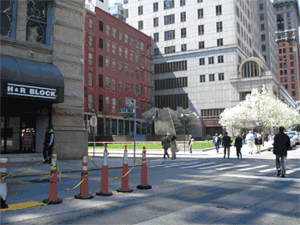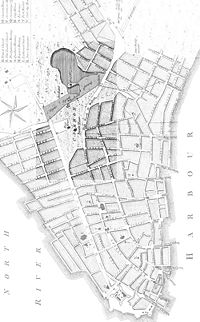| wiki | search |
Main Page | Groups and Assignments | Bios | History | Harlem | Diversity Today | Help
Colonial America | Early America | Modern America
History
When the Dutch West India Company settled on North American soil in 1626, they brought with them the first cargo of slaves; eleven Africans marked the beginning of the slave trade as they were put to work as farmers, hard laborers, traders and builders by the Dutch in New Netherland. These first slaves were responsible for the building of a protective wall and fortress that surrounded the area from English threats as well as docks and roads. Slaves were granted "half-freedom" which included basic rights like permission to join the church, baptize their children, marry into Dutch families, keep their families intact, testify and sue in court. Some had the liberty to manage their own time and some slaves were given parcels of land on the outskirts of town. It is believed (despite the lack of evidence) that the first slaves began burying their dead near the area for the secrecy it provided as well as the freedom to keep with traditional practices.
As the African Burial Ground has always been noted on maps, historians have always been aware of its existence, but believed that construction and destruction of the area must have demolished the site already. The rediscovery of the almost perfectly preserved burial ground shocked historians and the nation alike.
Rediscovery
The African Burial Ground was rediscovered in 1991 when remains were unearthed during the construction of the Foley Square Federal Office Building. Estimated to stretch over 5 city blocks, the African Burial Ground was located under some of the most expensive real estate in Manhattan. While approximately 300 sets of remains (ranging from grown men to women and children) were removed, it is believed that from the 17th to the 18th century, almost 20,000 blacks were buried in the ancient cemetary.
A shocking find for many, the African Burial Ground was the key that unlocked years of history that had been left unspoken. Slavery in New York had been prevalent since the formation of the colony, and when slavery was abolished, so was the work and contribution of the slaves to the creation of the city. Established as a National Historic Landmark in 1993, the African Burial Ground was given a monument in 2003 to honor the work and story of African-Americans in New York City.
Entitled The Door of Return in reference to The Door of No Return (a nickname for the slave ports of West Africa), the monument was designed by Haitian-American architect Rodney Leon.
Controversy

The rediscovery of the African Burial Ground faced controversy from the Black community regarding the excavation of the site, the treatment of the remains, the lack of African archaeologists and the selection of the winning memorial design.
Public outcry was heard from the Black community at the disturbance of the burials by construction workers. After the initial discovery was confirmed, only minor adjustments were made at the construction site. After massive protests, construction was fully halted and a new redesign was created to accommodate the area of the African Burial Ground that was unearthed.
Community members who volunteered to monitor the excavation process complained of improper treatment of the remains uncovered declaring it disrespectful. The lack of comment and input from African archaeologists was also noted and the appeal to turn over the excavation to a Black populated team and college was granted.
When the memorial design by Leon was selected, it was met with criticism from those who thought it was too commercial, favoring size over signficance and occupied too much of the land dedicated by officials. Some believed that nothing should be built on the land entirely. Nevertheless, officials went forward with the idea claiming that, "no longer should one walk past the site or throughout downtown and not be provided the opportunity to note, understand, and acknowledge with respect that history" (Leon).
Visit
The African Burial Ground Memorial is located at 290 Broadway on the corner of Duane and Elk Street in Lower Manhattan. For more information on this topic, visit [The New York Public Library's Schomburg Center for Research in Black Culture]
Image sources: ["Negro Burial Ground" Map], [graphic rendering of ABGM]


